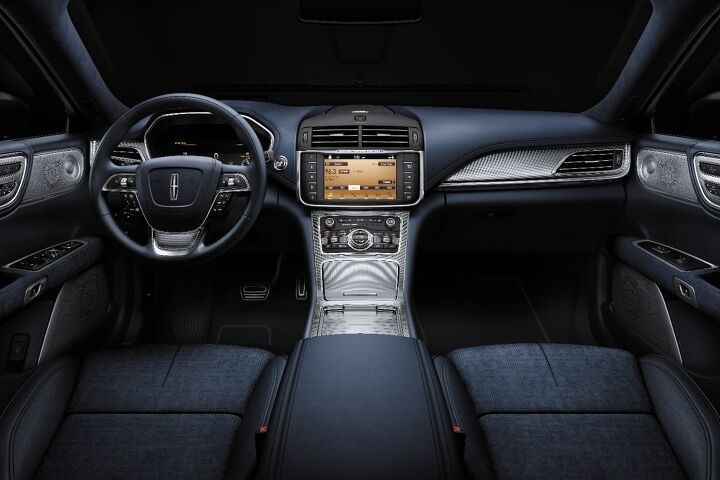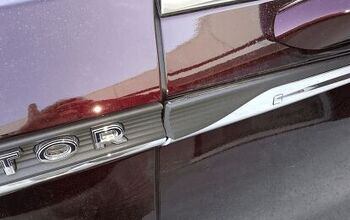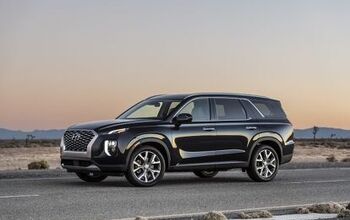What Will Lincoln Look Like in 2020?

Lincoln, eager to avoid the fate of Mercury, has spent years attempting to turn itself around. It’s a slow-and-steady kind of race. Rather than try to dazzle the public with a slick marketing campaign (confusing, perhaps – Ed.), Lincoln’s sticking to the fundamentals. Bludgeoned by the Great Recession, Lincoln’s sales actually began their steady decline in 2004, though by that time it had been losing market share for almost a decade.
Fortunately, things improved. While still far removed from its former strength, Lincoln’s annual domestic volume has stabilized at just above 100,000 units. Chasing sales will always be important for an automaker, but it’s not the main focus for Ford’s luxury nameplate. The brand believes that, if it can improve as a premium marque, volume will follow.
Even if you’re not a fan of its products, you have to admit that its newest models are a breath of fresh air. The Aviator (below) may not have the powertrain options of the MKT (above), but it’s better in every other conceivable way. You don’t even need to drive them; one can simply look at them side by side and sense there’s more going on with the Aviator.
The Corsair seems as though it will be a similar story. Replacing the MKC, the new crossover emits a sense of class its predecessor lacked. While examining the compact newcomer at the New York Auto Show, a Lincoln rep almost shuddered when we referenced the MKC — almost as if the brand was ashamed of it. However, those older vehicles were still quiet and comfortable automobiles, two qualities the brand isn’t willing to toss into the garbage for the sake of added performance. Comfort is king at Lincoln, and the brand wants to emphasize its strengths.
“It appears they’ve accepted who they are,” Jeff Schuster, president of global forecasting at LMC Automotive, said in a recent interview with Automotive News. “They’re not a volume premium brand that’s going to be everything for everyone. That’s OK; you don’t have to be everything to everyone to still be successful.”
Lincoln’s own design director, David Woodhouse, did nothing to refute that assertion. “It’s more about seduction than attack,” he said.
The brand’s new aviation/nautical theme is meant to remind customers of quiet and comfortable modes of upscale travel. But it also allows the company to abandon its failed alphanumeric naming strategy, which we always assumed was a foolish attempt to make it seem more German or Japanese. We couldn’t be happier with the change.
Lincoln chief Joy Falotico, who also broke things down for Automotive News, believes that the path ahead won’t include shortcuts or an emphasis on fleet sales. Falotico suggests that Lincoln should serve as a boutique brand, rather than a “luxury shopping mall” (poor Mark Fields), while admitting that volume is important. As the brand struggles to put down roots in China, Falotico claims the current strategy involves encouraging market growth “in a healthy way.”
By the end of this year, Lincoln will have four new utility vehicles on the market wearing updated (and much improved) sheet metal. Beyond that, Falotico said the brand will focus on gradually electrifying the lineup and ensuring customers don’t lose interest. “We’ve had to redo our whole philosophy of the cycle plan and add in an experience and service cycle plan and smaller packages that give you something new to show the customer,” she said. “They’re very sensitive to the freshness of the product.”
While most of what that means in terms of product is supposed to remain a mystery, Falotico did say the brand will provide extra performance packages and special editions. We also know that hybridization will begin creeping in as an option for most models (a plug-in Corsair follows the model’s launch by a year or less, with a potential EV on the horizon) and extra-premium variants are at least under development. It’s impossible to say if the strategy will pan out as desired, though it does look like the right play: a gentle rebranding aimed at gaining — and retaining — customers willing to splurge on higher-margin vehicles, coupled with improvements to its entire product line.
“We have a vehicle in every segment, except the luxury performance segment, so we feel we have roughly the right number of vehicles,” she said. “We’re not like some other manufacturers who don’t have mass-market brands, so you see them continue to extend their lineup. That’s not us. Having said that, we’re looking at derivatives that make sense.”
[Images: Ford Motor Co.]

A staunch consumer advocate tracking industry trends and regulation. Before joining TTAC, Matt spent a decade working for marketing and research firms based in NYC. Clients included several of the world’s largest automakers, global tire brands, and aftermarket part suppliers. Dissatisfied with the corporate world and resentful of having to wear suits everyday, he pivoted to writing about cars. Since then, that man has become an ardent supporter of the right-to-repair movement, been interviewed on the auto industry by national radio broadcasts, driven more rental cars than anyone ever should, participated in amateur rallying events, and received the requisite minimum training as sanctioned by the SCCA. Handy with a wrench, Matt grew up surrounded by Detroit auto workers and managed to get a pizza delivery job before he was legally eligible. He later found himself driving box trucks through Manhattan, guaranteeing future sympathy for actual truckers. He continues to conduct research pertaining to the automotive sector as an independent contractor and has since moved back to his native Michigan, closer to where the cars are born. A contrarian, Matt claims to prefer understeer — stating that front and all-wheel drive vehicles cater best to his driving style.
More by Matt Posky
Latest Car Reviews
Read moreLatest Product Reviews
Read moreRecent Comments
- Jalop1991 This is easy. The CX-5 is gawdawful uncomfortable.
- Aaron This is literally my junkyard for my 2001 Chevy Tracker, 1998 Volvo S70, and 2002 Toyota Camry. Glad you could visit!
- Lou_BC Let me see. Humans are fallible. They can be very greedy. Politicians sell to the highest bidder. What could go wrong?
- SPPPP Vibrant color 9 times out of 10 for me. There may be a few shapes that look just right in metallic gray, for example. There are a few nices ones out there. And I like VW "White Silver". But I'd usually prefer a deep red or a vibrant metallic green. Or a bright blue.
- 28-Cars-Later Say it ain't so, so reboot #6* isn't going to change anything?[list=1][*]V4-6-8 and High "Tech" 4100.[/*][*]Front wheel drive sooooo modern.[/*][*]NOrthSTARt.[/*][*]Catera wooooo.[/*][*]ATS all the things.[/*][*]We're *are* your daddy's Tesla. [/*][/list=1]







































Comments
Join the conversation
What will they look like? If the Zephyr is the car I anticipate, they'll be just a flagship short of the brand Cadillac should be. I don't know if the stock market will care, but customers are already taking notice.
Well, SUVs make up the bulk of sales for Mercedes, BMW, Audi, Lexus, Porsche, Jaguar. Acura, etc. The MKZ and Continental barely sell. I think that's your answer.